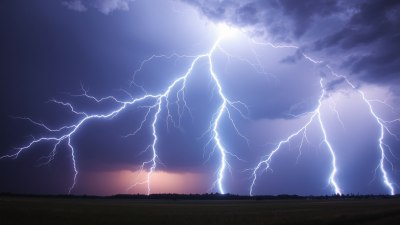Why Rain Sounds Different Depending on Where You Are
Discover how the environment affects the sound of rain and its varying perceptions across different locations.

Rain is one of nature's most soothing sounds, yet it can evoke different feelings depending on where we are. The sound of rain can transport us to a moment of relaxation, or it can remind us of a dreary day. But have you ever noticed that rain sounds different depending on your location? This article explores the factors contributing to the variation in rain sounds.
The Role of Environment
The environment plays a significant role in how we perceive the sound of rain. Each locale has its own unique acoustic characteristics influenced by various environmental factors. Urban areas with hard surfaces, such as concrete and asphalt, reflect sound waves differently than rural areas filled with trees and vegetation. In cities, rain may sound sharper and harsher due to the hard surfaces that bounce sound back, whereas in a wooded area, rain can sound duller as it absorbs some of the sound waves.
The Material Underfoot
The materials surrounding us can also significantly impact the sound of rain. When rain falls on a metal roof, for instance, the sound is loud and distinct due to the hard surface amplifying each drop. In contrast, rain falling on grass or soil produces a softer, muffled sound. The kind of surface beneath the rain – be it dirt, gravel, grass, or a wooden deck – affects how sound travels and is received by our ears.
Rain Intensity and Size
The intensity of the rain and the size of the raindrops also play crucial roles in how we perceive its sound. Heavier rain with large droplets creates a more significant impact when hitting a surface, leading to louder sounds. Light rain, on the other hand, produces a gentler patter that can be calming. Additionally, the sound created by different sizes of raindrops varies; larger drops create a more resonant sound, while smaller droplets produce a higher-pitched sound.
Wind Factors
Wind can also alter the sound of rain, acting as a sound modifier. When rain falls in calm conditions, the sound is often more pronounced. However, when it's windy, the sound may be buffered or distorted. Wind can carry raindrops away from our ears, affecting how we perceive the sound. Additionally, wind interacting with tree leaves can create a symphony of sounds that can either enhance or soften the auditory experience of rain.
Geographical Differences
Geographical factors can dictate not just the sound of rain, but also the overall atmosphere in which it's heard. For example, coastal areas may experience the sound of rain differently than mountainous regions. Coastal locations may benefit from the sound of rain harmonizing with ocean waves, creating a unique auditory experience that can blend the rhythm of both elements. In contrast, being in a forested mountainous area might produce echoes and deep resonance as sound bounces off rock formations and trees.
Culture and Perception
Cultural background and personal experiences also shape our perception of rain sounds. In some cultures, rain is associated with happiness and fertility, while in others, it may symbolize sorrow and melancholy. Additionally, individuals who have pleasant memories tied to the sound of rain may find it more comforting, while those with negative associations may perceive it as disruptive or sad. Thus, two people can experience the same rainfall, but their feelings towards the sound can vastly differ based on their backgrounds.
Psychological Effects of Rain Sounds
The sound of rain can have varying psychological effects depending on its acoustic properties and the individual's mindset. Studies have shown that rain sounds can reduce stress, promote relaxation, and enhance focus. For example, many people listen to rain recordings or white noise machines that mimic the sound of rain to help them sleep better or concentrate on tasks. Thus, understanding the diverse sounds of rain may not only deepen appreciation for nature but can also inform how we utilize these sounds for mental well-being.
Biophilia and Rain Sounds
The concept of biophilia, which refers to the innate human affinity for nature, suggests that the sound of rain can evoke deep emotional responses. Different environments and the associated sounds of rainfall can enhance this connection to nature. For example, in an urban setting, one might find serenity in the sound of rain on a rooftop, leading to a sense of calm amid chaos. In natural settings, the combined symphony of rain, rustling leaves, and distant thunder can create a profound sense of peace and connection to the environment.
Technological Aspects
With advancements in technology, various methods can simulate or reproduce the sound of rain. From ambient music apps to home sound systems, technology allows us to experience the calming sounds of rain even when we are indoors. Furthermore, sound designers and musicians often use the sound of rain as a backdrop or element in their compositions to foster specific vibes – demonstrating how rain's auditory nuances can be captured and manipulated to evoke emotions and enhance storytelling.
Coping with Rain
People adopt various coping strategies to deal with rain sounds, especially in areas where heavy rainfall is common. Learning to appreciate the distinct soundscapes created by rain can transform the experience from an annoyance to a form of natural music. Many individuals engage in mindfulness practices, focusing on the sounds of nature, including rain, as a way to cultivate another layer to their experience, often embracing the soothing and meditative qualities that rain can bring.
The Future of Rain Sounds
As urban development continues to grow and climate change alters rainfall patterns, the sound of rain will likely continue to evolve. In increasingly populated areas, the same rain sound can become an echo of the past, as human-made structures alter the acoustic environment. The interaction between nature and humankind’s modifications will produce new soundscapes that reflect these changes. Urban planners and architects may find inspiration in the characteristics of rain sounds, potentially designing spaces that enhance or preserve the auditory experience of rain in urban settings.
In conclusion, the sound of rain is a complex phenomenon influenced by a myriad of factors, including the environment, surfaces, weather conditions, and even cultural backgrounds. Embracing the diverse sounds of rain can provide a deeper appreciation for nature and its role in our lives. By understanding how location shapes sound perception, we can foster a greater connection with the natural world.











